U.S. Coast Guard PAs aboard the Eagle
This article originally appeared in the November 2016 issue of PA Professional.
By Hillel Kutler
The alleys between the mess hall’s long, brown tables constitute an ideal site to practice carrying stretchers for when they’d be most needed in the U.S. Coast Guard Cutter Eagle’s narrow corridors. The elegant wardroom, with a display case that includes a strip of the cutter’s original sail, would be utilized as a triage center if disaster strikes. First-aid training of staff is conducted almost anywhere on board.
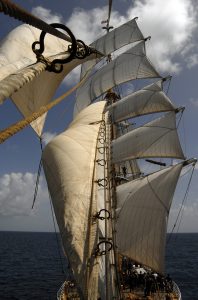
Throughout the 295-foot-long cutter—a “ship” in the Navy is a “cutter” in Coast Guard parlance—are stationed 20 kit bags, so well-stocked with the basics for handling emergencies that instructions are included. Painted arrows and medical-cross symbols appear in light-reflective red on interior walls—some just six inches from the floor, where sailors crawling in the dark would see them.
The 80-year-old cutter serves an important function for the U.S. Coast Guard Academy (USCGA), and attention to detail helps keep those on board healthy and safe, according to PAs who have served aboard the tall ship. PAs have been a part of this branch of the Uniformed Services since the early 1970s. In fact, the first PA commissioned to serve in the Coast Guard was Victor “Vic” Germino, Jr., who has the distinction of being a member of the first class to graduate from the Duke University PA program on Oct. 6, 1967.
Now, PAs are firmly entrenched in the Coast Guard and among the medical professionals staffing the Eagle. The largest tall ship flying the stars and stripes, and the only active square-rigger in U.S. government service, it can berth up to 237 people. That number includes the crew and those in training when the cutter is at sea for several weeks at a time. The trainees are mainly USCGA cadets and officer candidates, along with some from the U.S. Naval Academy and elsewhere.
Lt. Cmdr. Tommy Brackins, U.S. Coast Guard, retired, PA-C, had always wanted to serve on the cutter. Last summer, before he retired, he checked it off his bucket list. He spent 22 days on the tall ship, sailing from Bermuda to Portland, Maine, to Boston.
Along with seizing the opportunity to provide care on the tall ship, he also mentored and taught crew members about leadership.
“I spoke with cadets, junior officers, and enlisted members regarding career progression and certain careers in the Coast Guard,” said Brackins, who served in the Coast Guard for 23 years, 13 of them as a PA. “I am also an Aeromedical PA (flight surgeon trained PA), which opened up the communication channels with a number of cadets who desired going into Coast Guard Aviation.”
Brackins, who calls Gatlinburg, Tenn., home, was the third highest ranking officer onboard the Eagle during the 2015 voyage.
Healthcare on the High Seas
Every summer, the Eagle sails in the Atlantic Ocean for several weeks of training in such basics of seamanship as learning to read the wind and sea, steering, navigating by the stars, and raising and lowering the sails. The time at sea also builds teamwork and develops leadership capabilities.
The rest of the year, the cutter is moored at the USCGA’s base in New London, Conn., or sails to other American ports for public relations and outreach purposes. Currently, it’s in the midst of a four-year program of maintenance and refurbishing each winter. Those repairs are done at the Coast Guard’s repair facility at southern Baltimore’s Curtis Creek, just inland from the Chesapeake Bay.
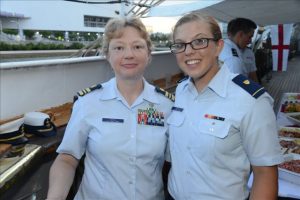
“I love it,” said Lt. Cmdr. Charlene Criss, U.S. Coast Guard, PA-C, who served on the Eagle approximately 10 times in the past decade. “It’s the camaraderie with the crew. You see the most beautiful sea, sunrises, sunsets and stars anywhere. I had no idea I’d love it this much.”
On a recent, dreary morning, workers were waterproofing the Eagle’s cables, thoroughly cleaning hoses’ interiors and stripping pipes of their paint to prepare for a fresh coat. In the galley, a cook placed tins on the counter to begin preparing lunch. An announcer tested the public-address system: the cutter’s whistle, the alarm for a collision and a signal to dispatch sailors to their stations.
There were about 50 people on board to handle deck, navigation, engineering and seamanship operations as well as support staff, such as the cooks. Adam Carter, a corpsman and health services technician, was on duty. On-the-job injuries and workers getting sick can occur at any time in port or at sea, of course. Carter also occasionally leaves the sick bay to monitor food conditions, such as ensuring that proper storage temperatures are maintained and looking for any evidence of rodents’ presence.
Even while the cutter is docked, the PAs’ medical tasks continue apace. “We would gladly see anyone at any time,” said Brackins. “I had members knock on my berthing room door after hours needing help.” On the Eagle, all medical notes are handwritten and prescriptions are filled from the limited medication supply onboard the cutter. The medications covered most of the essentials such as antibiotics, NSAIDS, muscle relaxants, cough and cold medications, and even narcotics if needed. And on a typical day, PAs see crew members with “Uri’s, pink eye, seasickness, musculoskeletal disorders, and life adjustment issues with being underway.”
Brackins said that PAs can also perform limited CLIA waived lab testing such as urine dipstick, urine pregnancy, mono spot and rapid strep. They could also do minor procedural interventions such IV fluid rehydration, wound repair, nebulizer tx, unguinectomies, I&Ds and splinting.
Tight Quarters
The Eagle’s sickbay is a tight, L-shaped room that’s less than 100 square feet. It lacks equipment like an X-ray machine and a real lab, but it contains plenty. A defibrillator hangs next to a porthole, alongside an eye chart. Atop a file cabinet sits a blue advanced-cardio-life-support bag. Next to it is an EMT pack.
A cabinet stores an oxygen tank, one of many on board. File drawers display labels for things like antibiotics, antifungals, pain medications, ophthalmic medications, dental supplies, needles and syringes, bandages, scalpels, wound care, water testing, sutures. Medical books stand on a shelf across the room, since the Internet isn’t always available. The room might resemble most small clinics, except for the homemade sign taped to the sick bay’s door:
Seasickness Medication:
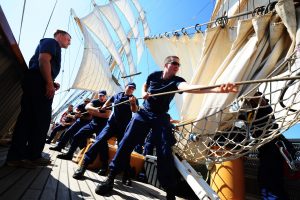
If you feel OK, just drink water.
If you know you get sick, chew one now.
It will give you a dry mouth and mild drowsiness.
Drink water!!!
Do not give to your shipmates.
If you’re sick, go on deck.
No more than 1 2X a day!
Unsurprisingly, seasickness pills are well stocked. A few hours before the Eagle sails, those on board are asked if they tend to get seasick; if they do, they’re given a chewable tablet, which is good for a day, ora patch that lasts three days.
Being at sea also means increased risk of sunstroke and dehydration. That’s why the medical staff circulates on sunny days to hand out sunblock lotion, and almost every day to make sure that people are drinking enough water. Space restrictions mean that bottled water isn’t stocked. Still, drinking supply is hardly an issue: A reverse osmosis filtration system makes the seawater potable.
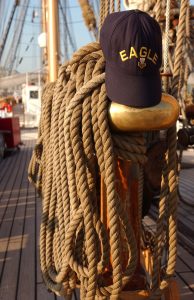
The Challenges Are Unique
About six years ago, when the cutter was sailing off the coast of Colombia, almost everyone on board had presumed food poisoning said Criss, who has been a member of the Coast Guard for more than 24 years.
Anti-nausea medications and anti-diarrheals were given out, and IVs utilized. The three medical professionals on duty “worked non-stop to take care of people,” she said.
Another time, a patient had food stuck in his esophagus. Criss, who has been a PA for about 15 years, used a combitube to successfully force the food down into the man’s gut. On land, she would have sent him to an emergency room. “It worked, thank goodness. If it didn’t work, he was going to have to be medevaced,” she said.
The cutter’s distance from land represents the greatest challenge to health care, the PAs said. In difficult circumstances, satellite telephones are used to reach an advisor, known as a flight surgeon, who is trained to consult from a distance. Preparation and the ability to think on one’s feet are paramount.
“You have to deliver a high level of care on board because you’re kind of ‘it,’” said Lt. j.g. Robert Prevatt, a PA from West Palm Beach, Fla., who served on the Eagle in the summers of 2014 and 2015. A PA for about three years, he has served in the Coast Guard for nine years.
Criss noted, “There are a handful of quick tests we can do. There’s a finite number of medications and supplies, and we can’t restock until we get to port, and there’s no specialist on board, so there’s no way to tell for sure if, say, someone has a broken bone, unless you see it. There’s pressure because you have to make a lot of decisions. A lot of times, you’re on your own and have to rely on your own knowledge and skills.”
An unusual challenge that healthcare professionals aboard the tall ship face is the configuration of the vessel itself. Because of the masts and sails, helicopters cannot evacuate a patient from the deck. The solution: The patient and several crew members are lowered in one of two 35-foot motorized lifeboats. The boat travels away from the cutter, and the helicopter lowers a basket. The patient is secured in it and is raised to the helicopter, whereupon the crew members return to the tall ship.
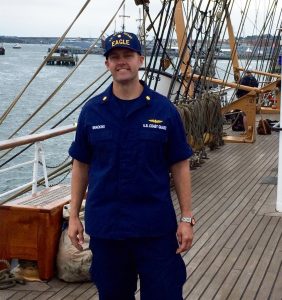
from Bermuda to Boston.
In the summer of 2015, a squall—a sudden burst of strong wind, often accompanied by heavy rain—struck the tall ship, yanking a pin rail from the side of the deck. A pin rail is a horizontal wooden ledge-like plank with a row of holes in it, in which belaying pins hold the lines rising to the sails and the mast. When it tore away from the side of the vessel, it could have struck someone flush. Fortunately, said Criss, who was on the cutter then, no one was hurt.
Accidents are liable to happen though, she explained. Hydraulic equipment and other heavy items can fall when being moved. The cutter will roll and lurch without warning. Head trauma can result.
“A ship is a dangerous place,” said Criss, who hails from Falmouth, Mass., a town on Cape Cod familiar with tall ships. Lt. Cmdr. Tommy Brackins, retired, spent 22 days aboard the Eagle, sailing from Bermuda to Boston.
A Fascinating Place to Work
This vessel is a historical place, too. On the wall of a the corridor leading to the captain’s quarters hangs a framed tribute to author Alex Haley, who worked as a messboy in the Coast Guard in 1939 and wrote part of his landmark book “Roots” while a guest on the Eagle in the early 1970s. Further along, a photograph shows President John F. Kennedy and Vice President Lyndon B. Johnson standing on the deck in 1962. Another picture shows President Harry S. Truman visiting.
It was during Truman’s presidency that the tall ship became American property after being captured during World War II. A plaque on another wall states that it was German-built and originally named Horst Wessel. A staircase near the plaque brings a visitor down to the mess deck, where meals are eaten and that doubles as an unofficial medical annex—beyond the stretcher-bearing drills. Open a door to the lounge room and one will glimpse a high-definition television playing a film; the lounge doubles as a battle-dressing station, containing items like IV fluids, splints, triage tags, gauze pads and nasopharyngeal airway kits.
Serving on the Eagle is a singular experience for PAs and the crew members for whom they care.
“Anytime you have to leave your family behind it is a challenge, but the friendships you make on the Eagle can last a lifetime,” Brackins said.
Hillel Kuttler is a freelance writer. Contact him at [email protected].
Thank you for reading AAPA’s News Central
You have 2 articles left this month. Create a free account to read more stories, or become a member for more access to exclusive benefits! Already have an account? Log in.



